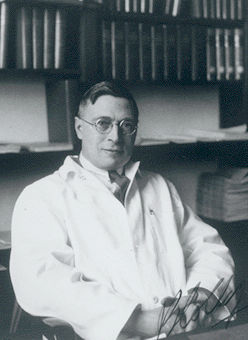Insulin
Insulin is a peptide protein hormone. It is secreted by the beta cells in the "internal" (hormone) secretory portion as distinct from the "external" (digestive enzyme) secreting portions of the pancreas. It has a molecular weight of 5800 and is composed of 51 amino acids. The molecule is composed of an A and a B chain connected by 2 disulfide bridges. One milligram equals 24 international units. When insulin is released into the blood, the liver retains 40-60% of it. The liver is also the major site for insulin degradation. The synthesis and release of insulin is regulated by a moment-to-moment relationship between concentrations in body fluids of substances such as glucose, amino acids and hormones and receptors on beta cells, and by the activities of the sympathetic nervous system. Among the former substances, glucose is the principal stimulant and among the latter activities epinephrine is the principal inhibitor.
Insulin is the most potent hormone of fuel storage, affecting carbohydrate, fat and protein throughout the body. Acting through binding to receptors on cell membranes, the principal targets of insulin are in liver, fat and muscle. Concentrations of glucose, free fatty acids and amino acids decrease in the circulation as a result of augmented insulin action, and fuels are thus stored. The breakdown of these fuels (catabolism) and the release of their breakdown products into the circulation are inhibited and tissue growth is facilitated by augmented insulin action.
During exercise, when there is need for fuel mobilization for the requirements of contracting muscles, there is co-ordinated inhibition of insulin release in association with the release of counter-regulatory hormones such as epinephrine, glucagon, cortisol and growth hormone. Insulin has been made available for treatment of diabetes mellitus by extraction from beef and pork pancreatic islets since the discoveries of Sir Frederick Banting, Charles Herbert Best, John James Rickard Macleod, James Bertram Collip in 1921-22. (See also The Discovery of Insulin). Recently through genetic engineering, biosynthetic human insulin has become available. It has replaced the previously supplied animal-source insulins.

 Share on Facebook
Share on Facebook Share on X
Share on X Share by Email
Share by Email Share on Google Classroom
Share on Google Classroom





